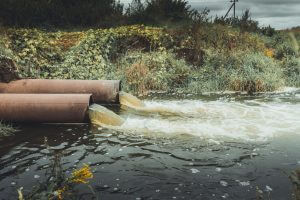Managing urban runoff
Do you live or work in the Delaware River Basin? Find specific contact information in your state and learn about ways to address runoff in your watershed here.
One of the leading sources of contamination to our rivers is polluted runoff. As we replace forests, fields, and other natural surfaces with streets, parking lots, buildings and homes, we prevent rain from soaking into the ground to be absorbed and released by plants. Instead, when it rains, water falls on impervious or water-resistant surfaces like pavement, collecting sediment, bacteria, oils, metals and other pollutants. The more water-resistant the surface, the less potential there is for pollutants to be absorbed by soils and vegetation.
In urban areas, this stormwater either flows into the sewer system and is released after treatment at wastewater facilities to nearby streams, or is discharged directly to waterways through storm culverts. Significant precipitation events can overwhelm wastewater facilities and result in combined sewer overflows, dumping even more pollution into streams. Even without big storm events, aging and poorly designed infrastructure can result in unintended discharges. Excessive stormwater discharge can also contribute to habitat degradation (scouring and erosion) and unnatural hydrology within the receiving waterways.
Stormwater and Combined Sewer Overflows (CSOs)
Stormwater and combined sewer overflows (CSOs) are both regulated under the Clean Water Act with varying success. The scope of the stormwater program under the Act is limited, so learning whether your community falls under stormwater regulations is a critical first step. Once you know that, you can begin to build your approach. Use the links in the “learn more” section to begin your discovery.
In recent years, the scientific and technical understanding of how to control stormwater has evolved toward “volume-based” controls that attempt to keep more water on-site to better protect, restore and replicate natural hydrology. Practices known as “green infrastructure,” including rain gardens, green roofs and tree planting in urban areas, help reduce polluted runoff and CSOs while also providing additional community benefits like energy savings, flood reduction, water reuse, and cooler temperatures. Take a look at the resources provided on this page to learn more about national stormwater programs, innovative solutions, and state-of-the-art best practices for turning water that runs over our streets into a community benefit.
Learn More
- River Voices: Green Infrastructure and Urban Rivers by River Network
- National Pollution Discharge Elimination System (NPDES) by River Network
- Stormwater Pollution Permits by River Network
- Compendium of State Post-Construction Standards by U.S. EPA
- Permitting Green Infrastructure: A Guide to Improving Municipal Stormwater Permits and Protecting Water Quality by American Rivers
- Stormwater Management by Center for Watershed Protection
- Stormwater Institute by Water Environment Federation
- Rooftops to Rivers: Using Green Strategies for Controlling Stormwater Runoff and Combined Sewer Overflows by NRDC
- Closing the Clean Water Gap by Conservation Law Foundation





